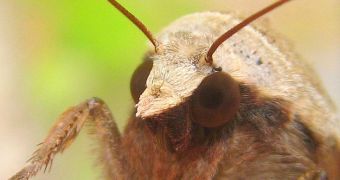Scientists have been trying to obtain the perfect glare- and reflection-free displays for many years, but thus far their efforts have been in vain. Now, after turning to nature for inspiration, experts believe they may have just discovered a means of making these advanced devices a reality. They say that the only thing that needs to happen in order for such displays to become possible is for science to become able to recreate the advanced patterns that exist on moths' eyes. These insects provide inspiration for experts given their highly-developed sense of sight, LiveScience reports.
One of the main things that make moths' eyes so suitable for this type of research is the fact that evolution made the insect develop very special traits. In addition to its large field of view, and the keenness of its eyesight, the moth also benefits from eyes that do not reflect sunlight. This is absolutely necessary in order to avoid predators. Birds and other animals looking for an easy meal would make short work of flies, if only they could have some indicator of where they are. The lusterless eyes have always captivated researchers, and especially those working in producing transparent plastic screens.
The creatures' eyes are basically covered with anti-reflective “bumps,” which scatter light very efficiently. Scientists have been working on emulating these structures for many years, but thus far only very fragile, and also expensive, replacements have been obtained. “There's very little moth eye out there. It's one of these Holy Grail products that if you could make it in large quantities and also have it be scratch-resistant, it would be a huge breakthrough,” explains the president and CEO of Conneticut-based company Reflexite, Michael Foley. Recently however, German researchers at the Fraunhofer Institute for Mechanics of Materials IWM, in Freiburg, announced progress in this field.
The team managed to modify a production line in such a manner that the intricate moth eye patterns are inscribed on plastic during a stage called injection molding. This means that the etching no longer has to be performed in a separate step, and implies that the end product will also be more scratch-resistant than anything currently on the market. The German group also developed a new coating material for the mold chamber, to which plastic oftentimes adheres, ruining the intricate and delicate displays. “There is still a lot of work to be done, but our results are very promising,” explains IWM project manager Frank Burmeister.

 14 DAY TRIAL //
14 DAY TRIAL //